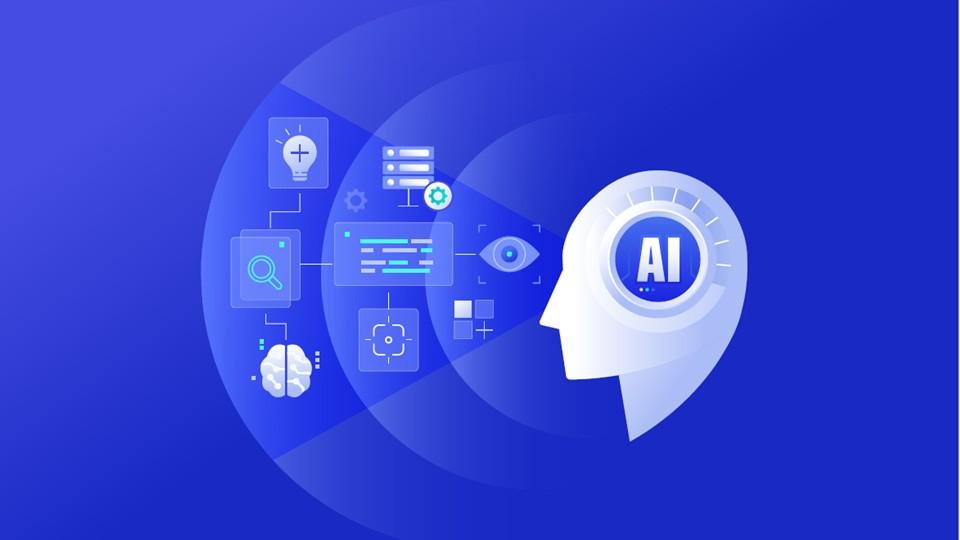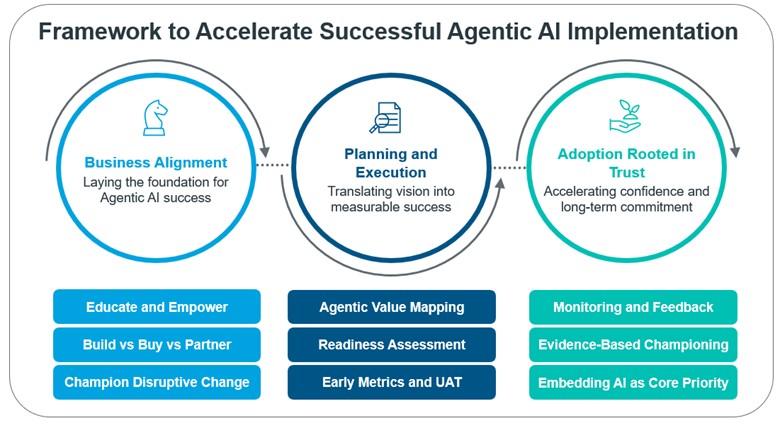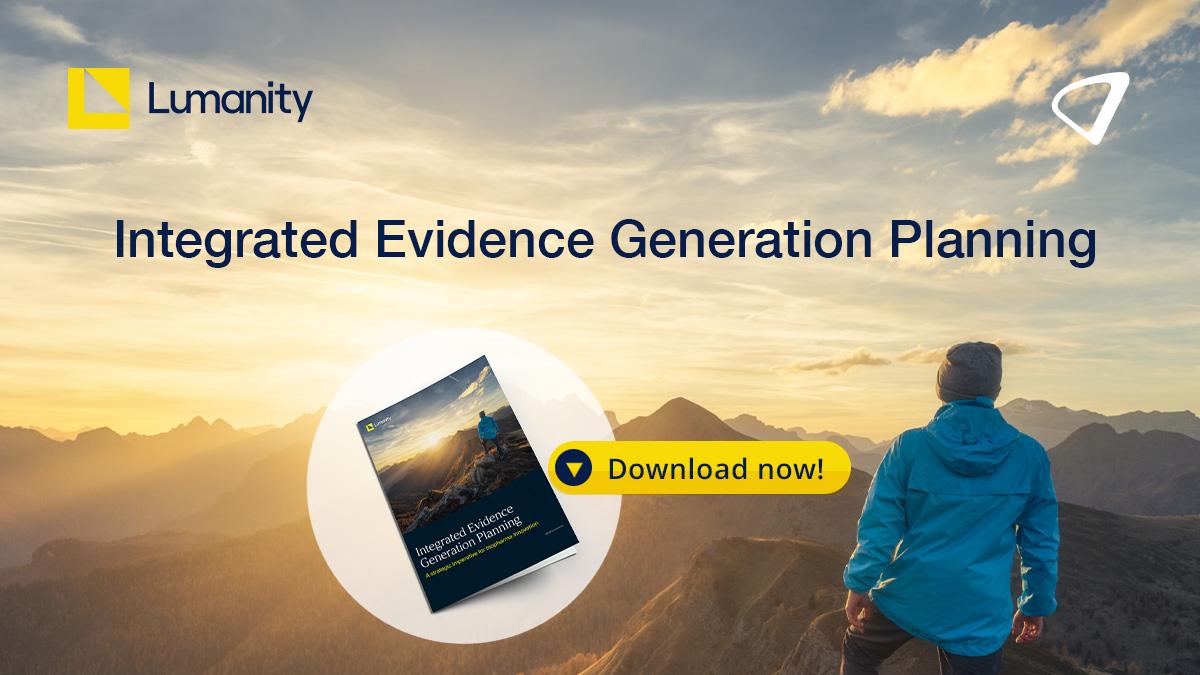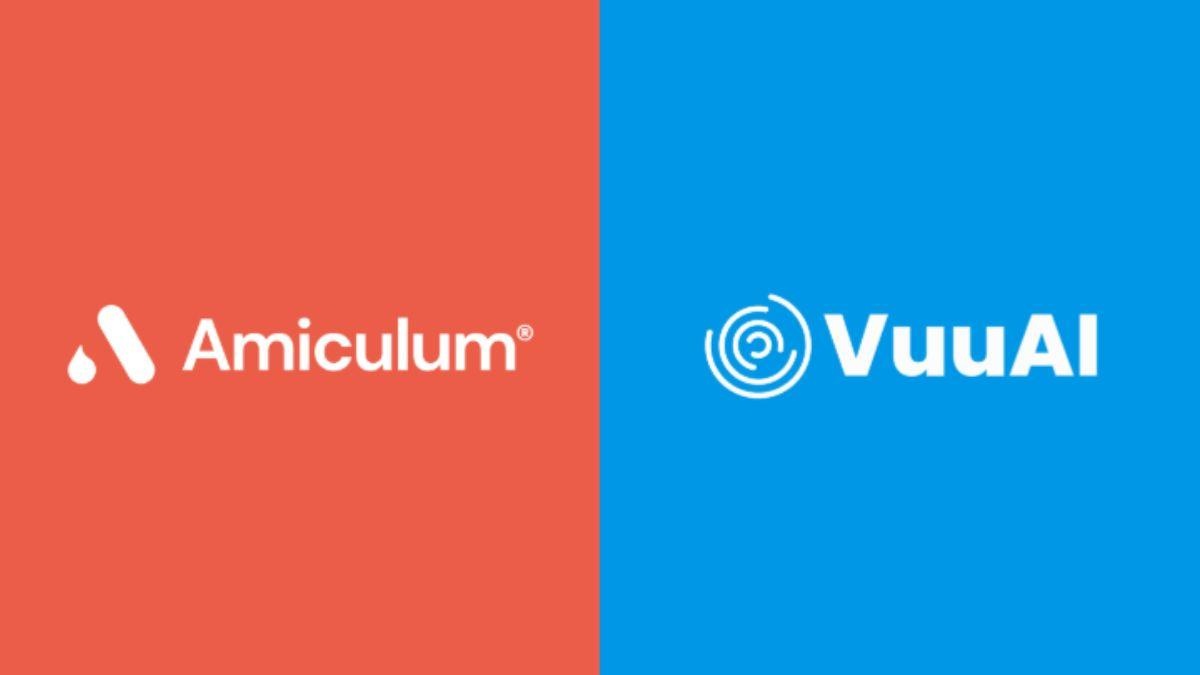Balancing innovation and implementation: Embracing agentic AI as a strategic enabler in healthcare

Agentic AI – autonomous systems capable of independent decision-making – is reshaping healthcare and life sciences. From streamlining administrative workflows to complex applications like sales force optimisation and market opportunity analysis, its potential is vast. Forrester research indicates that 75% of companies independently deploying agentic AI will face challenges, and one in four will encounter significant hurdles. A structured approach, rooted in clear use-case evaluation and impact assessment, is essential to success.
The three-stage framework below guides organisations through their agentic AI journey, ensuring effective ecosystem development.

Stage 1. Business alignment: Laying the foundation for agentic AI success
Business alignment ensures that AI initiatives are strategically positioned to drive measurable value while avoiding inefficiencies or misalignment with organisational goals. Stage one involves fostering a shared understanding of agentic AI – its principles, applications, and ability to drive measurable impact. Why? Because agentic AI will truly change the workflow of impacted users and reshape operations.
Think of a high-throughput assay analogous to agentic AI. A high-throughput assay in life sciences is designed to rapidly analyse multiple compounds, delivering fast, scalable insights. Similarly, agentic AI operates as a high-throughput system for decision-making and automation, constantly evaluating extensive data streams, performing reasoning and planning, and executing autonomous actions at scale.
With this change, leaders must frequently communicate a clear vision and mission to establish the “why” and “why now”, and actively dismantle organisational silos to address high-value agentic initiatives. Simply identifying something as a high priority can mislead leaders to think this will automatically result in collaborative progress. Active leadership involvement is critical for resolving challenges, such as high-level priorities misaligned with day-to-day objectives, perceptions that immediate wins cannot be attained and lack of clear ownership and accountability.
Moreover, leadership should communicate how disruptive change will happen, otherwise there can be a fear of being stuck in “pilot mode”. Early on, organisations should assess their build vs. buy vs. strategic partnership strategy to optimise resources and outcomes and accelerate deployment. While building in-house provides control, it demands expertise and investment; buying accelerates adoption, but may limit the extent of desired customisations. Effective partnerships provide accelerators, integrating state-of-the-art external capabilities and can potentially be a more cost-effective option.
Stage 2. Value mapping & readiness: Prioritising the right agentic AI use cases
Launching agentic AI programs without a clear roadmap can lead to wasted resources and failed adoption. Organisations should begin by engaging across teams and encouraging them to submit use cases, along with champions who can oversee high-level prioritisation. These champions must comprehend the principles and applications of agentic AI to ensure that prioritisation accounts for readiness and identifies potential commonalities across various use cases, thereby maximising the impact of agentic AI.
Before starting proof-of-concept (PoC) development, three key exercises need to be performed to mitigate bottlenecks or blockers.
The first exercise involves value mapping of use cases, where there is a use case breakdown to identify where reasoning-intensive tasks occur. For each of these tasks, there is further assessment done to estimate where the most time and effort is spent, so that realistic expectations can be set on ROI.
Second, as part of the value mapping, there should be an understanding of underlying dependencies (e.g., data, APIs, SOPs, etc.) to mitigate bottlenecks or blockers in the PoC development phase.
Third, teams should go through a scoping exercise that can time bound the PoCs to last four to eight weeks (depending on the use case complexity, data readiness, and technical requirements) to test these estimations/assumptions.
If not carefully managed, these PoCs may suffer from scope creep, leading to costly delays in determining whether to discontinue the project or advance it to a minimum viable product (MVP). Simpler projects like chatbot agents may take less time (e.g., three to four weeks), while more complex, data-intensive PoCs may require up to eight weeks or more. This structured approach enables fail-fast testing, ensuring only PoCs that prove out initial KPIs and dependencies are moved forward for further development.
Agentic ecosystems are inherently transformative, designed to reshape workflows and enhance operational efficiency. To ensure successful implementation, user-driven acceptance testing (UAT) plays a crucial role – engaging early adopters to refine AI outputs through human-in-the-loop mechanisms helps uncover critical nuances that might otherwise be overlooked.
Early UAT not only validates AI agents’ reliability, but also assesses their potential to drive productivity and innovation. Establishing design workshops early in the process ensures development is aligned with a superior user experience, fostering seamless adoption and maximising impact.
Stage 3. Adoption rooted in trust: Building confidence in AI integration
The successful adoption of agentic AI hinges on trust; trust in its capabilities, reliability, and long-term impact. Without a strong foundation of confidence among users and stakeholders, even the most advanced AI solutions risk limited adoption. To foster trust, organisations must integrate continuous monitoring, evidence-driven validation, and a commitment to AI as a core priority.
Continuous monitoring and feedback integration ensures AI evolves alongside user needs. Rather than deploying AI as a static solution, organisations must implement iterative learning cycles that incorporate human-in-the-loop mechanisms to monitor and provide better feedback on previous actions and implement methods like reinforcement learning to improve results over time. By collecting real-world insights and refining AI models dynamically, this human-AI collaborative approach not only enhances AI’s effectiveness, but also reinforces trust by demonstrating adaptability and responsiveness to shifting demands.
Evidence-based championing is a trust-building mechanism that plays a crucial role in credibility. AI adoption accelerates when users see tangible results, similar to JP Morgan Chase’s graduated approach with AI trading systems, which started with shadow trading before allowing limited autonomous operations. Organisations should prioritise rigorous testing and proof-of-concept validation, showcasing efficiency improvements, accuracy gains, and workflow enhancements. This should include multiple trust metrics such as system reliability scores, user satisfaction ratings, error correction rates, and response accuracy measurements. Transparent reporting on AI’s successes – and its limitations – ensures realistic expectations and strengthens buy-in from key stakeholders, particularly in regulated industries like healthcare, where trust concerns are heightened.
Finally, embedding AI as a core priority reflects a long-term commitment, moving beyond the notion of a temporary experiment. By integrating AI into an organisation’s innovation strategy, rather than treating it as a standalone initiative, it can establish robust and sustainable adoption frameworks. Following a successful PoC/MVP, the focus should shift from change management to change reinforcement strategies. This transition may involve revising internal processes to align with the AI system and implementing comprehensive training programmes to help users navigate changes. Achieving this transformation requires dedicated champions, strategic investment, and a clear vision for AI’s role in reshaping business operations.
What it means for commercial life sciences
While efficiency gains are a natural focus, the true potential of agentic AI lies in its ability to unlock new competitive advantages. For example, consider primary market intelligence. Beyond accelerating the generation of qualitative and quantitative market insights, agentic AI will empower organisations to now capture time sensitive intelligence that legacy processes would otherwise miss due to lengthy human-dependent steps and processes. The speed and precision of AI-driven insights do not just enhance decision making, they enable businesses to anticipate market shifts, respond proactively, and innovate faster.
By embracing agentic AI as a strategic enabler, life sciences organisations can move beyond operational improvements to reshape industry dynamics, gaining an edge in an increasingly complex and data-driven commercial landscape.
About the authors
 Avinob Roy is VP & GM commercial analytics product offerings, global technology solutions, at IQVIA. Roy has 18+ years of experience in technology, data, and analytics and leads teams that develop cutting-edge analytics solutions specifically tailored to navigate the complexities of the healthcare and life sciences industry. With an extensive background in pharmaceuticals, Roy leverages his deep industry insights to craft technology and AI-driven tools meticulously designed to fostering business growth and market transformation for his clients.
Avinob Roy is VP & GM commercial analytics product offerings, global technology solutions, at IQVIA. Roy has 18+ years of experience in technology, data, and analytics and leads teams that develop cutting-edge analytics solutions specifically tailored to navigate the complexities of the healthcare and life sciences industry. With an extensive background in pharmaceuticals, Roy leverages his deep industry insights to craft technology and AI-driven tools meticulously designed to fostering business growth and market transformation for his clients.
 Pooja Jain is director of product offering and strategy at IQVIA. Jain leads global commercial initiatives for life sciences. She has over 15 years of experience working across the drug development life cycle, including R&D, preclinical assessment, and marketing. Jain has extensive experience working with informatics solutions and has a proven track record in cross-industry collaborations, such as with regulatory bodies and large pharma. Currently, Jain is overseeing omnichannel and commercial generative AI strategic initiatives that leverage the data and analytics ecosystem to drive high-value insights that can lead to improved cost efficiency and greater market impact for life sciences customers.
Pooja Jain is director of product offering and strategy at IQVIA. Jain leads global commercial initiatives for life sciences. She has over 15 years of experience working across the drug development life cycle, including R&D, preclinical assessment, and marketing. Jain has extensive experience working with informatics solutions and has a proven track record in cross-industry collaborations, such as with regulatory bodies and large pharma. Currently, Jain is overseeing omnichannel and commercial generative AI strategic initiatives that leverage the data and analytics ecosystem to drive high-value insights that can lead to improved cost efficiency and greater market impact for life sciences customers.











